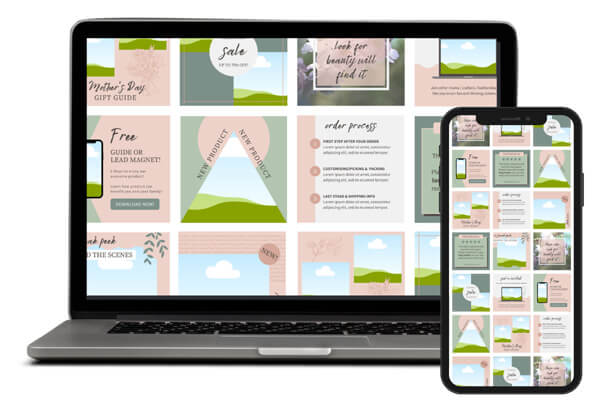

How can you use your content to grow your business?
The key to success lies in your strategy.
The basics of a content strategy is the plan for how you will create and promote your content. It includes things like, what the overall goals for your content are, what kind of content you will create, and what platforms to promote and share it on.
Your content strategy plan should ensure that all of your content has a purpose in mind. Your plan will help you stay consistent with your messaging and branding that works together to attract your ideal audience.
Without a content strategy, you could waste time creating content that’s simply fluff – does nothing for your business and totally misses the mark.
Creating a content strategy doesn’t have to be difficult or take lots of time. I’m personally a fan of using easy and simple, yet super-effective methods to grow my business.
That’s why I’ve come up with seven steps to get your content to work for you – and actually help to grow your business.
Follow the steps outlined below to create a winning content strategy plan to help you grow your business:
The first first step is to decide on the goals for your content.
What do you want the content you publish to achieve? For example, do you want to increase brand awareness, drive traffic to your website, or generate new leads?
It’s up to you as to how many goals you want, but I recommend having one main objective and no more than 2-3 other smaller specific goals to help you stay focused on what you’re doing and trying to achieve.
Don’t be afraid to be detailed about the goals of your content, including narrowing down the purpose of one particular piece of content.
Here’s where using SMART goals can help you, so each goal should be specific, measurable, achievable, relevant, and time-bound.
So an example might be:
I want to increase engagement on Instagram by 30% by posting helpful content 3 times a week and relatable humor content 2 times each week. I will do this with a combination of static posts, carousel posts, videos and stories.
Who do you want to reach with your content?
Creating personas for your ideal customers will help you understand their needs and how they like to consume content.
Brainstorm your ideal audience’s goals, objections and pain points.
Then, with this information in mind, you can create content that appeals to them and speaks to their specific problems and goals.
I’ve done this myself with a spreadsheet I created with columns for each thing. For pain points for example, I scoured things like Facebook group posts and Instagram post comments to find out what people were asking for help with. So in Facebook groups you could also search for phrases like “[niche] suggestions” or “[niche] problem.”
After you’ve collected this information, you can easily create content that:
Content pillars are like categories or buckets, each has different content types or themes within.
Deciding what should be your content pillars is made easy if you’ve done the above task. As you’ll know what content your audience with find helpful, what solutions are they searching for and what do they want to achieve.
I recommended having no more than 5 content pillars to help keeps things simpler for you and to avoid confusing your audience.
Some content pillar examples include:
Employing social proof as a content pillar, is essential in my opinion because it’s how you can overcome peoples fear or objection over working with you. Sharing customer testimonials will help put people at ease and help them to trust you and your offerings.
It’s important to write valuable content such as social media captions that accurately describe and add value to your content.
If you need help with writing compelling captions, check out this post with swipeable social media caption templates, or consider joining the content creation membership and get fresh fill-in-the-blank captions and Canva templates every month.
When creating good content, it’s crucial to ensure that it’s both interesting and informative, providing value to your audience.
Consider if your content can help solve a problem or if it’s entertaining. Ask yourself if your content is something that people would actually want to read or watch. Will it help them to solve a problem? Is it entertaining?
It may be tempting to reshare (or copy) memes and videos that went viral. While sharing viral content may seem like a quick fix, it’s important to make sure it aligns with your ideal audience’s interests.
If your content doesn’t resonate with your target audience, it may attract people who aren’t genuinely interested in your business.
To get some inspiration for your content, check out these ideas for blog posts – which can also be adapted to social media posts and even your marketing emails.
Talking of blog posts, learn how to use call-to-action graphics to get more leads from your articles – a no doubt important part of your content strategy!
Once you’ve created great content, don’t let it sit there in one place!
If you’ve written a blog post, you can divide it up into snippets for social media posts, you can summerise it for an email newsletter and you can also turn it into a video.
If it’s a social media post, can do the same but in reverse – plus you could share it as a post in a private group or forum, link directly to it from an email and/or turn it into an ad.
Some of the ways I love to promote my content is by collaborating with others in my niche and finding suitable influencers and bloggers to promote my offers to their audience.
Remember more who see it, the more likely your content marketing will achieve your goals!
After you’ve published your content, it’s important to take some time to analyze how well it performed.
Look at things like website traffic, social media engagement, and conversion rates.
Here are the key stats that you’ll want to track:
Then you can make informed adjustments to your content and startegy based on your findings.
The best way to keep your content strategy effective is to create new, fresh content on a regular basis.
This doesn’t mean you have to publish a new post every day but you should have a regular publishing schedule that you stick to.
By continually putting out new content, you’ll keep people coming back for more and eventually achieve your goals.
Save yourself time and energy creating social media content by using Canva templates. Using templates helps you to create new posts quickly and helps you stay consistent and on-brand with your content.
Consistency is vital if you want to be successful with content marketing.
A well-thought-out content strategy will help you be consistent with your messaging and branding and keep you from time wasters. After all, publishing content that doesn’t serve a purpose wastes time and resources.
Another thing to keep in mind is that as your business grows and evolves, so should your content strategy.
By following these seven steps, you can create a content strategy to help you grow your business.
Planning out your content strategy is crucial for growing your business, but creating visually stunning and consistent graphics can be time-consuming. That’s where our professional Canva templates come to the rescue.
Visit the Canva templates shop and explore the wide range of expertly designed templates for entrepreneurs to help streamline the content creation process.
Whether you need eye-catching social media posts, engaging Pinterest pins, or engaging story templates, we’ve got you covered.

Share to…

Sign up to get 10 free Canva templates for your social media.
Created with solopreneurs in mind, these templates offer a variety of content types to help boost your online presence!